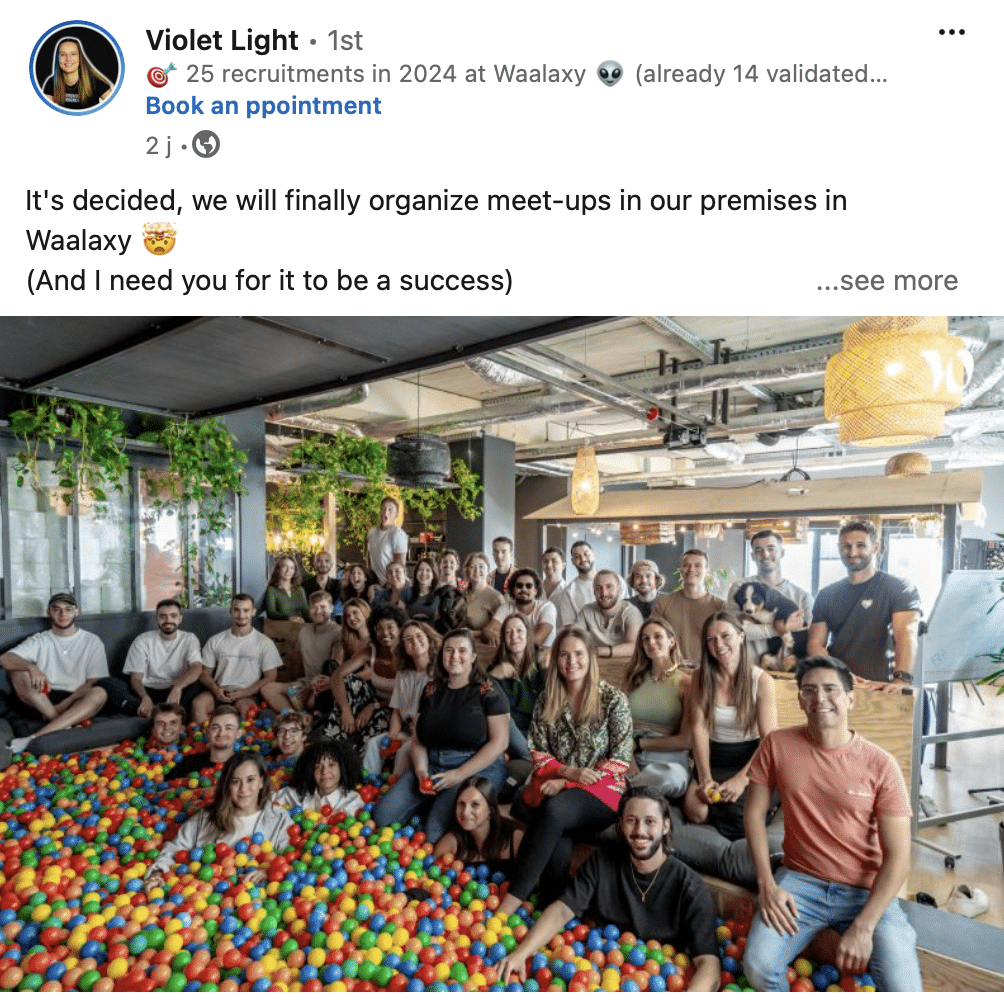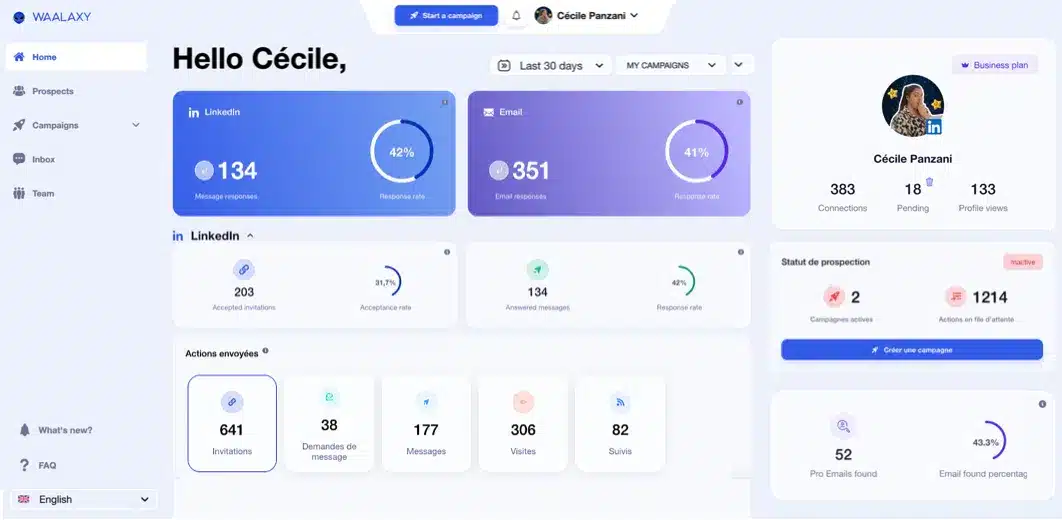An application pool is like a gold mine for recruiters. Imagine a database filled with interesting profiles, promising CVs, and unsolicited applications, ready to be used when the need arises. 👀
Rather than starting from scratch every time you recruit, you already have a pool of assessed and interested candidates, making the process much smoother and faster. 🚀
Why make a candidate pool?
Having a pool of candidates is essential for several reasons:
- Saving time: Having a ready supply of candidates means you can recruit more quickly when a vacancy arises. No need to start from scratch every time! ⏰
- Cost savings: Less expenditure on advertising and recruitment costs. A well-managed recruitment pool reduces overall recruitment costs. 💰
- Quality of hire: Direct access to qualified candidates who are already interested in the company. This increases the chances of finding the right person for the right job. 🏆
- Employer brand: An active talent pool shows that the company values candidates and maintains long-term relationships. This creates a positive image and inspires confidence in future talent. 🌟
How to create a candidate pool in 3 steps?
To create an effective applicant pool, it’s important to distinguish between two approaches: traditional recruitment and headhunting.
Headhunting is a recruitment method where recruiters actively seek out qualified candidates, often already in post, for specific positions.
Here’s how to proceed in three steps, with best practices for each method, to build up a good pool of candidates. 💼
1. Collect applications
Classic recruitment:
To attract the right profiles and enrich your applicant pool, you need to write attractive, clear advertisements. Here are a few tips:
- 📝 Write good ads : Make sure they’re complete. Include the company’s values, what your benefits are… of course describe the position as well as the skills required. For example, if you’re looking for a web developer, mention specific technologies like JavaScript, React, or Python.
- 👩🏻💻 Choose the right platforms : Post your job offers on recruitment channels recognized as reliable, such as Indeed, LinkedIn, or Welcome to the jungle. You can also post them on sites specialized in your sector, for example, for technical positions, Stack Overflow or GitHub Jobs.
Headhunting:
Use tools like LinkedIn Sales Navigator to easily identify and contact potential candidates on LinkedIn. Thanks to its advanced filters, you’ll be able to find very specific profiles. This tool allows you to identify the most relevant profiles:
- 🔎 List interesting profiles: Use lists with names like “Senior Developer”, “Digital Marketing”, or “Project Manager” to organize your candidates. This enriches your candidate pool with quality profiles.🗂️
2. Organize and segment candidates
Classic recruitment:
Use a CV reader to automatically sort incoming applications. Classify them by type and skills:
- 📋 Application type: You can separate them, according to their origins: unsolicited applications from those responding to a specific advert.
- 🏆 Skills: You can also classify candidates according to their main skills. For example, group candidates into categories such as “SEO“, « Administrative », “Human Resources”. This segmentation allows you to better manage your applicant pool.
Headhunting:
Segment candidates use specific tags for their skills and experience. The tool I recommend is Waalaxy. It can be a great asset for recruiters and headhunting professionals. It allows you to optimize prospecting and candidate management. With advanced features such as specific tags, tags will save you time, especially if you use prospecting tools to import several dozen candidates each time:
- 📌 Specific tags: You can use tags like “5 years experience”, “MBA”, “Montpellier” to make it easier to find and manage profiles. This organization makes it easier to track interesting profiles and enrich your application pool in a structured way.
3. Communicate with candidates 📢
Classic recruitment:
To keep candidates interested in your application pool, you can send :
- 💌 Invitations to events: For example, invite your candidates to webinars, networking sessions or open houses at your company.
- 📨 Newsletters: send regular newsletters with company updates (sales, new benefits, success stories…), job offers, and career advice to keep candidates engaged.
Headhunting:
In this case, LinkedIn is your ally, post regularly to improve your employer’s brand and attract talent :
- 📱 LinkedIn Posts : For example, share employee testimonials, articles on company culture, or project success stories to enhance your candidate pool.
- 💼 HR branding : Use relevant LinkedIn hashtags and visuals to maximize the impact of your posts. You can also have a team member act as your “spokesperson”.
At Waalaxy, Violette Léger, our “Head of human resources” shares our values, highlights our new features, such as the upcoming introduction of meet-ups, and our corporate vision.👀

But it’s not just her! In fact, several members of the team are on LinkedIn and share a certain vision of Waalaxy through their posts. Don’t forget that your employees are a reflection of your company, and could well become your best ambassadors! ⭐️
What’s the difference between a talent pool and a candidate pool?
At first glance, you might think they’re similar concepts, but there are a few minor differences:
- The talent pool is a larger, strategic group. It groups together people who could be of interest to your company for future positions. These talents possess skills and experience, and can be invited to apply for specific positions when opportunities arise. A “talent pool” can include former candidates, event attendees and people who have expressed an interest in working with you. 🌟
- The candidate pool is more specific. It includes people who have passed the pre-selection stage and are being seriously considered for a position. These candidates are usually invited to interviews or assessments. They represent a small proportion of all applicants, but have a higher level of interest and compatibility with the company’s current needs. 👥
Although there are slight disparities, the steps for creating a candidate pool and a talent pool are similar. They involve defining segmentation criteria, creating lists based on these criteria, and maintaining communication with the people present in these pools.👀
Improve your candidate pool with Waalaxy
Waalaxy is the perfect tool for improving and optimizing your applicant pool. Here’s how you can use it to facilitate your recruitment processes.
1) Search for new profiles and import them from LinkedIn
With Waalaxy, you can easily find new talent using LinkedIn targeting and import them directly into your database. Here’s how it works:
- 🔍Search for new profiles: use LinkedIn’s advanced search filters to find candidates matching your criteria. For example, if you’re looking for a web developer, you can filter by JavaScript skills, geographic location, and work experience.
Tips: Waalaxy is also compatible with Sales Navigator! You’ll be able to use it for multiple Waalaxy accounts.
- 📥 Automatic import: Thanks to the Waalaxy extension, you no longer need to manually copy and paste profile information. The tool automatically imports candidate data directly into your database, saving you precious time.
- 🗂️ Centralized management: Once profiles have been imported, you can easily manage and organize them in Waalaxy. You’ll find a summary sheet for each profile.

2) Create candidate lists
Use Waalaxy to create and manage candidate lists based on your segmentation criteria. When you add your profiles to Waalaxy using LinkedIn, you can first place them in a list. Once the import is complete, you can create tags on Waalaxy and assign them to each profile. You can sort candidates by skills, experience…
➡️ For example:
- “Candidates not selected, but interesting career path”
- “Management skills
These lists enable you to keep an overview and target your recruitment actions more easily. What’s more, you can assign several tags to a candidate if he or she matches different segments. 📋
3) Automate your communication with your pool
Launch Waalaxy automated prospecting campaigns to stay in touch with candidates, keeping them informed of new opportunities and news. This will keep your pool active and engaged, while saving you time!
We explain how in this article! 👉🏻 Here !
Tips: Thanks to Waami, our message-writing AI, your messages will always be interesting and personalized. 🤖
4) Candidate tracking and updating
Keep your lists up to date with information on candidates and their interactions with your campaign. With the Waalaxy interface, you can easily find out how many have been contacted, how many have responded, but also how many are still in the campaign and plan the next actions. 🔄

How about a recap?
By following the three key steps described in this article, you can create an effective and strategic candidate pool. Here’s a quick summary:
- 📥 Collect profiles: Write attractive, comprehensive ads to attract the right profiles and publish them on the right channels. Also use headhunting tools like LinkedIn Sales Navigator to identify specific candidates.
- 🗂️ Organize and segment candidates: Use CV-reading tools and tags to classify profiles by skills and experience…. This makes it easier to manage your candidate pool and target your actions.
- 📢 Communicate with candidates: keep candidates interested by sending invitations to events, newsletters and posting regularly on LinkedIn to enhance your employer brand.
Using Waalaxy is perfect for managing a candidate pool, as it allows you to search, segment, and communicate effectively with your candidates. 👀
These practices will help you build a pool of quality candidates, always ready to respond quickly to your recruitment needs. 🚀
Frequently asked questions
What are the different types of application?
- Unsolicited applications: Candidates apply without there being an open position. Practical for finding motivated people! ✉️
- Applications following job advertisements: Direct responses to your advertisements show that candidates are interested in the particular position.
- Internal recommendations: Your employees recommend people they know. This is often a guarantee of quality! 👥
- Applications collected at events : You meet candidates directly at events. It’s great for evaluating people face-to-face! 🎓
- Applications from online platforms: Indeed, Welcome to the jungle, LinkedIn… these platforms let you reach a wide audience and diversify profiles. 💻
How can you diversify your applicant pool?
Have you followed all the steps? You may find that you come across rather similar profiles over time. Here are some bonus tips for diversifying 😉
- Encourage unsolicited applications : let people know you’re always on the lookout for talent, even without an open position. 📬
- Participate in events: Go to fairs, job fairs, and events in different sectors to meet different profiles. 🎉
- Use other social networks: LinkedIn is a must, but you can use others like X (Twitter), and even Instagram. They can be channels for finding atypical candidates. 📱
- Set up referral programs: encourage your employees to recommend candidates. It’s often very effective! 👫
- Target different candidate profiles: Look for recent graduates, experienced pros, people in retraining, international talent… be open to all horizons! 🌍
- Collaborate with schools and universities: Participate in partnerships with schools, masterclasses… to meet interesting profiles right from their training. 🎓
I hope this article helps you set up your application pool!












